 Many athletes recognize the value of using yoga to increase their performance, maintain stamina in the off-season, and reduce the overall risk of injury. This includes golfers. But what if you’re not familiar with the sport or how it can wreak havoc on the body? What if you’re not sure how to meet the needs of your club-swinging students? This blog post will highlight 5 essential elements you can confidently address when using yoga for golfers.
Many athletes recognize the value of using yoga to increase their performance, maintain stamina in the off-season, and reduce the overall risk of injury. This includes golfers. But what if you’re not familiar with the sport or how it can wreak havoc on the body? What if you’re not sure how to meet the needs of your club-swinging students? This blog post will highlight 5 essential elements you can confidently address when using yoga for golfers.
You might be wondering why I’m addressing how to use yoga specifically for golfers instead of talking about yoga for athletes as a whole. The truth is that I absolutely love the game of golf. A decade ago that surely wasn’t the case. Yet my husband suggested I give it a try so we could enjoy a shared outdoor sport.
On our first venture to a small course, and on the very first tee, I hit my ball within 1 foot of his. My form was horrible–tainted by the many years of swinging a baseball bat–but I had the strength and coordination to drive the ball down the fairway.
Turns out, the mental and physical components of the game got me hooked immediately. And since I golf a few times a week during the summer months, I use yoga personally to offset the asymmetrical patterns of the game. I’ve also developed The Flexible Golfer online program that shows golfers how to use yoga to care for their bodies when off the course. By sharing this information with you today, it’s my hope that you will gain a greater respect for how the body moves in golf–and how you can use yoga with your clients to enhance their wellbeing (whether you take up the sport yourself or not).
WHY YOGA FOR GOLFERS
Golf is a challenging sport that requires strength, stamina, finesse, and focus. In fact, the numerous demands it places on the entire being is what gets many people hooked on the sport in the first place (and keeps them coming back for more).
What many underestimate, however, is that the golf swing itself can be very taxing on the body. In fact, it requires most of the joints of the body to move through a large percentage of their maximum range of motion. And, the body must do so at a high speed! Because most golfers don’t take the time to learn the components of the swing, or how the body moves through the swing, they end up with injuries.
That’s where you come in!
You get to educate your golfing students. While they may think that poor swing mechanics are causing their aches and pains, it’s really their lack of mobility and body control that perpetuate their discomfort.
And when you show them how to establish a golf-ready body with yoga, your students can stay safe and healthy while playing golf at a higher caliber. Plus, they’ll increase the likelihood they can play well into the golden years of their lives.
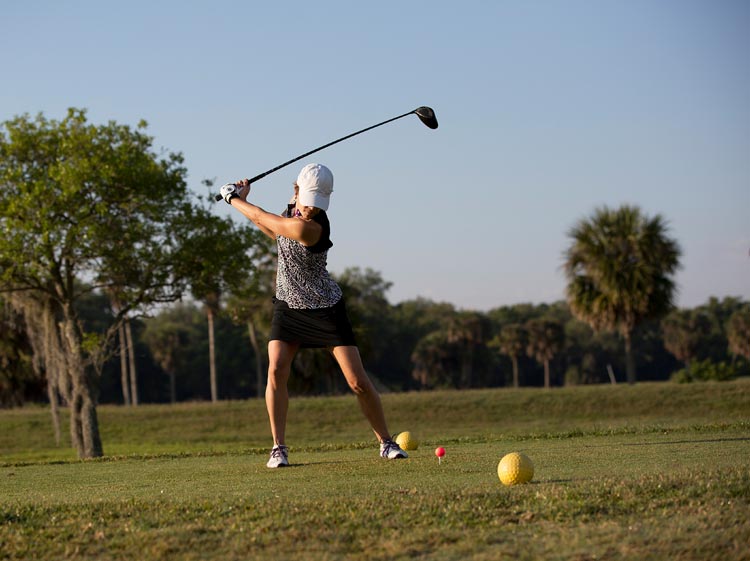
Photo Credit: Ember and Earth
A GOLF-READY BODY
The golf swing is a very unique skill that requires an integrated chain of accurate movement in the body. And each person has a very unique swing because they have a very unique body. Each golf swing is unique, just like a fingerprint. And because the physical condition is also different in each golfer, it might be impossible to get the swing of one person to look like anybody else’s.
Instead, the goal is to make each golfer body capable of creating the most efficient swing that they can produce. This is actually just like yoga in that we don’t expect the version of each posture to look the same for each person. Often, we need to modify and adapt the asana so that students can maintain their steady, rhythmic breathing.
Craig Davies, the author of Golf Anatomy, says, “the most effective way to improve a golf game is to improve the quality of the body playing the sport. As players are in better control of their bodies, it becomes easier to improve the technical part of their game because now they have more movement options available.”
So essentially, as a yoga professional, you want to use yoga as a way to help your clients refine their most valuable instrument on the golf course–their bodies! To do this, I suggest you address the five key elements of a golf ready body: These elements are mobility, balance, body awareness, strength, and power.
Now let’s take a closer look at how you can use yoga for golfers to enhance each of these areas.
(1) MOBILITY
Mobility is the range of motion available in the body that you can control. Many golfers who are unfamiliar with yoga assume it’s a practice designed to increase flexibility. And, yes, that’s true. Yoga increases the length of your muscular tissue, as well as joint range of motion.
As yoga relates to a golf-ready body, however, you don’t just want to be flexible. You want to be mobile. You want to control your flexible muscles as they go through a wider range of motion. Said another way, mobility is how you stabilize your flexibility.
Essentially, then, you want to use yoga for golfers to build both their flexibility and stability in sport-specific ways. Here’s how:
 Where to increase flexibility for golfers:
Where to increase flexibility for golfers:
- The hamstrings. The ready position for golf involves a slight hinge at the hips. This means the back body, like the hamstrings and QL, need to be long. Use poses like ardha hanumanasana and supta padangustasana to do this.
- Internal hip rotation. When golfers take their backswing, their trail leg (leg furthest from the ball) internally rotates. Poses like garduasana (eagle) and hero’s pose are a great way to increase this capability in your golfers.
- External hip rotation. While the back hip internally rotates during the backswing, the front hip externally rotates. Postures like warrior 2 are an active way to increase external rotation, while seated poses like sukhasana and reclined figure 4 also do this, too.
- The spine, which is made up of 33 individual bones stacked one on top of the other, contains multiple joints at each level. Spinal twists to increase flexibility in all parts of the spine help improve any golfers swing capability.
Where to increase stability for golfers
- The hips. Stabilizing the hips is one of the best things you can do in yoga for golfers. Lateral movement of the hips when swinging the club is the most common reason for frequent mishits on the course and lots of frustration. So, practice building stability here to give your golfers a solid foundation from which to swing.
- The shoulder complex. The shoulders are not only responsible for lifting the club away from the ground, but they also help the body slow down from this powerful motion. Thus, use exercises like shoulderblade pushups, tabletop, and plank train golfers to stabilize their shoulder joint before playing.
(2) BALANCE
What makes golf unique when compared to many other athletic activities is that the surface of the ground is unpredictable throughout the game. The slope, the firmness, or even the type of surface changes all the time. One minute your student could be playing on firm short grass with a downhill slope, and the next they might be hitting out of soft sand with an uphill lie.
This requires a significant amount of balance and coordination in the lower body so that the appropriate posture of the spine can be attained and maintained throughout the swing.
How to increase balance:
- Activate the feet. Yoga for golfers is really similar to teaching new students how to practice. Simple poses like tadasana, where feet press firmly into the floor, teaches foot awareness.
- Balance on one foot. Use standing postures, like Utthita Hasta Padangusthasana or tree pose, to increase balance in your golfers.
(3) BODY AWARENESS
The next element to address is body awareness. This is often known as proprioception, which is just a fancy way of saying that your body understands how it is moving in relation to other parts of itself and the environment in which it exists.
This is not something that you consciously have to be aware of or think about really. Your body has incredible body wisdom to gather that information at all times. This is done through sensory organs called mechanoreceptors.
These mechanoreceptors are located throughout the body, including an especially high density in the feet, and they receive information from the body’s physical environment. From there, they send that information to the brain via the connective tissue and nervous system.
In the broadest sense, yoga heightens awareness of your entire body. On a subtle level, it also increases the accuracy of how that information is received and it increases the speed of which that information is processed.
This translates directly to increased levels of coordination within the body, especially during a golf swing. Thus, any kind of work you do on the yoga mat with your golfing students will help increase this element.
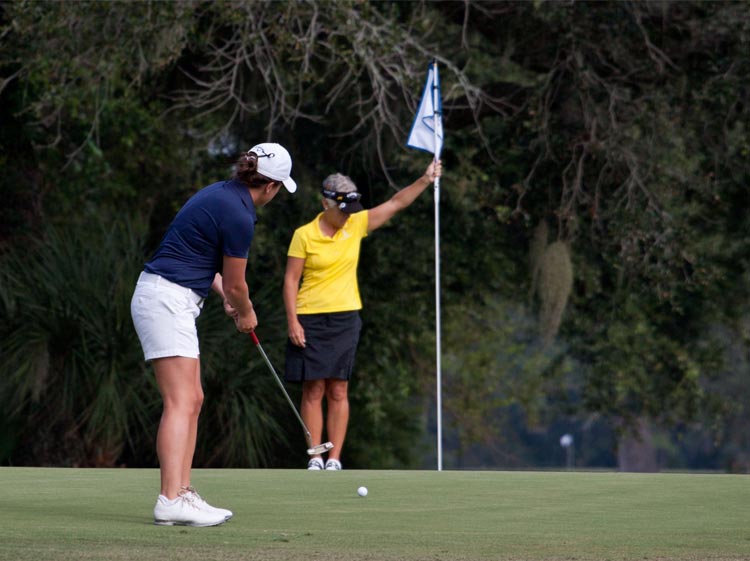
(4) STRENGTH
The fourth and fifth elements of a golf ready body go hand in hand. The first of these is strength, and it’s important because golfers need the capacity to withstand the great pressures on their body during a golf swing. And since one round of golf involves repeating the same motion 70-100+ times, the ability to be energized over time is necessary for a golf-ready body.
Yoga poses to build strength in golfers:
- Chair pose, which is a great to build lower body strength and stabilize the hips at the same time.
- Warriors 1 and 2. Both poses involve a firm foundation, which increases balance, all while increasing muscle mass in the legs.
- Horse stance. This posture builds stamina in the legs while also increasing external rotation of the hips
- Plank pose. Yes, the upper body and lower body both need to be strong in golfers. Thus, plank is an all-around great posture to address the muscles of the legs, core, and shoulders.
(5) POWER
Power is the explosive element of golf that allows your students to not only complete the dynamic movement that is the golf swing, but it also allows them to hit the ball further. Yoga for golfers is a great way to build the power necessary in golf since yoga poses integrate so much of the body at once.
Ways to build power with yoga:
- Sun Salutations. Surya Namaskara A and B increase the ability to move with strength, coordination, and ease. Teach your golfers these sequences to increase their power.
- Dancing warrior sequence. The dancing warrior sequence, originally designed by Shiva Rae, requires the body to be strong, flexible and balanced through a series of movements. This occurs in both the lower and upper portions of the body, which will greatly benefit your golfers.
- Nakrasana. Crocodile pose requires the strength of plank pose with the coordination of plyometric pushups. Just make sure you modify for your clients if they are not capable of the full posture.
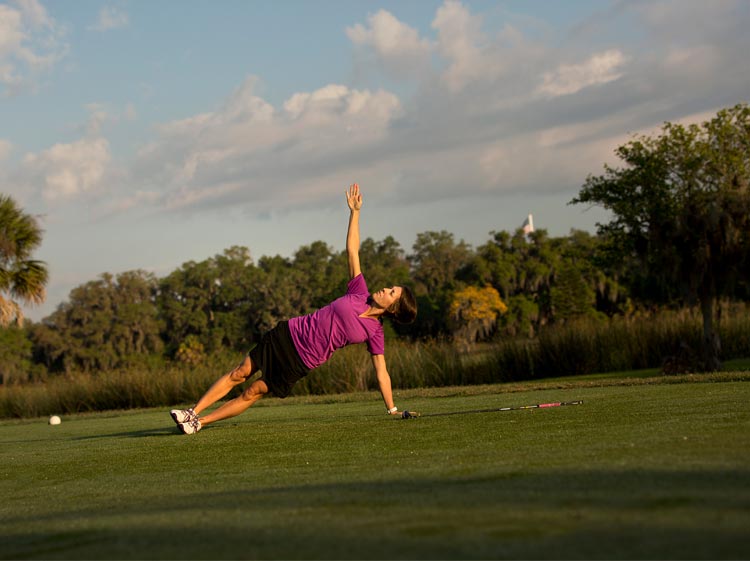
Photo Credit: Ember and Earth
PUTTING IT TOGETHER
There are so many ways to use yoga for golfers today. By understanding the five elements to address with your club-swinging clients, you can confidently and seamlessly help them improve their overall health and game performance. Just remember, you get to educate them on why yoga for golfers is beneficial. This includes perks such as:
- Increased joint mobility, especially in the spine.
- Improved balance when standing and swinging on any surface.
- Enhanced body awareness and coordination via improved nervous system sensitivity.
- More strength, since their muscle can contract at a higher capacity.
- Increased power, as stronger muscles are able to move in greater harmony during the golf swing.
- Enhanced health of the body’s connective tissue, or fascia. This is really important because the connective tissue provides flexibility, structure, balance, and communication throughout the entire body!
Take Action Now:
- Send out a survey to your community and find out which of your students play golf.
- Set up a workshop or private session with your golfers to help improve their health and game performance.
- Tell them about the Flexible Golfer online course. We do offer financial perks for yoga professionals who refer this program to their clients. Contact me to find out more!





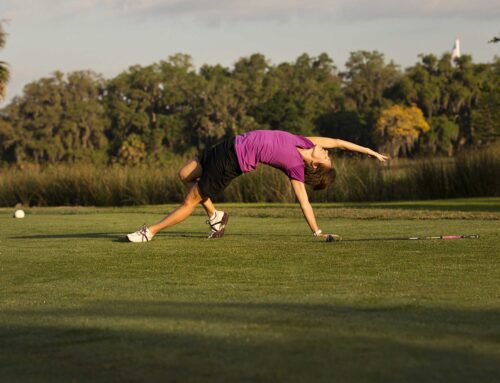

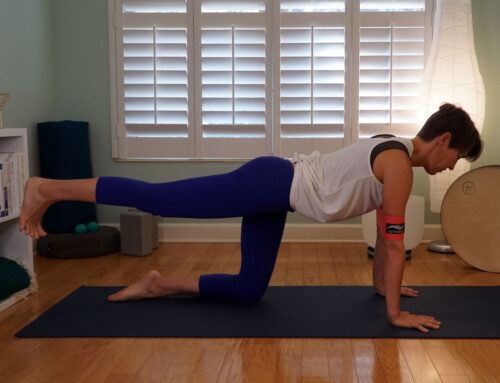
Leave A Comment